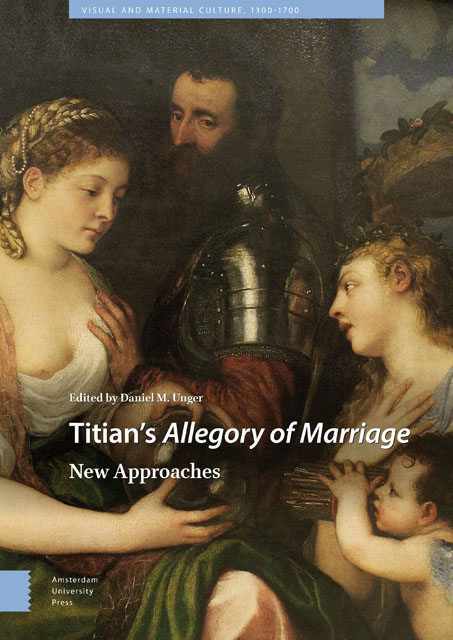Book contents
- Frontmatter
- Table of Contents
- List of Plates and Figures
- 1 Introduction: Poetic License
- 2 Love, Beauty, and the Human Body as a Reflection of the Divine
- 3 Amorosa visione: Titian’s Allegory of Marriage and the Poetry of the Half-length Format
- 4 The Arms and Armour of Titian’s Allegory of Marriage
- 5 ‘Un disio sol d’eterna gloria e fama’: A Literary Approach to Titian’s Allegory
- 6 Psyche, Venus, Ceres and Their Friends: Titian’s Remixes
- 7 Art and the Double Meaning of Reflection in Titian’s Allegory of Marriage
- 8 Titian’s Allegory of Marriage as an ‘Allegory of Peace’
- 9 Vision and Touch in the Allegory of Marriage
- 10 Of Crystal Orbs and Divinatory Mirrors : The Vicissitudes of Pregnancy and Artistic Agency in Titian’s Allegory of Marriage
- Index
1 - Introduction: Poetic License
Published online by Cambridge University Press: 16 November 2022
- Frontmatter
- Table of Contents
- List of Plates and Figures
- 1 Introduction: Poetic License
- 2 Love, Beauty, and the Human Body as a Reflection of the Divine
- 3 Amorosa visione: Titian’s Allegory of Marriage and the Poetry of the Half-length Format
- 4 The Arms and Armour of Titian’s Allegory of Marriage
- 5 ‘Un disio sol d’eterna gloria e fama’: A Literary Approach to Titian’s Allegory
- 6 Psyche, Venus, Ceres and Their Friends: Titian’s Remixes
- 7 Art and the Double Meaning of Reflection in Titian’s Allegory of Marriage
- 8 Titian’s Allegory of Marriage as an ‘Allegory of Peace’
- 9 Vision and Touch in the Allegory of Marriage
- 10 Of Crystal Orbs and Divinatory Mirrors : The Vicissitudes of Pregnancy and Artistic Agency in Titian’s Allegory of Marriage
- Index
Summary
Titan's Allegory of Marriage (Plate 1), in the main hall of the Louvre's sixteenthcentury-painting wing, attracts little notice these days. Compared to the fame of Leonardo da Vinci's Mona Lisa in the centre of the gallery and the massive scale of Veronese's Marriage at Cana on the other side of the gallery, facing the Mona Lisa, which draw most of the visitors’ attention, Titian's painting seems to fall short in terms of both its popularity and its size.
The label alongside the painting is ambiguous, reading: ‘Allégorie Conjugale, dite à tort Allégorie d’Alphonse d’Avalos’ (Allegory of Marriage wrongly named Allegory of Alfonso d’Avalos). Moreover, although the exact date of the painting is unknown, the label notes that it was completed c. 1530/5. The short explanation represents the most common interpretation of the painting today: Titian created an image of a married couple with the spouses, who were figured as Mars and Venus, accompanied by the protective divinities of marriage: Cupid, Vesta, and Hymen, bearing their respective attributes—arrows, myrtle, and a basket of flowers and fruits. The crystal ball on Venus's knees is another attribute, which together with the melancholic facial expressions of the main protagonists suggests the loss of a life. The couple is destined to be parted in the future because one of the two will leave this world. Viewers reading this label might easily come to the conclusion that Titian depicted a sad and rather uncommon marriage and may experience both perplexity and astonishment, even a sense of mystery—awakening one's curiosity as if standing before a riddle. Why would Titian have created a painting of such a sad marriage and who would have wished to commission such an uncommon theme?
At the same time, the use of the term ‘allegory’ calls upon us to look beyond a straightforward definition of what is depicted in the painting. This vein was explored in the nineteenth century by Abraham Hume in his 1829 Notices of the Life and Works of Titian, where he remarked on the difficulty in understanding the allegory represented in this painting. Georg Gronau repeated this contention in 1900.
- Type
- Chapter
- Information
- Titian's Allegory of MarriageNew Approaches, pp. 13 - 26Publisher: Amsterdam University PressPrint publication year: 2022

